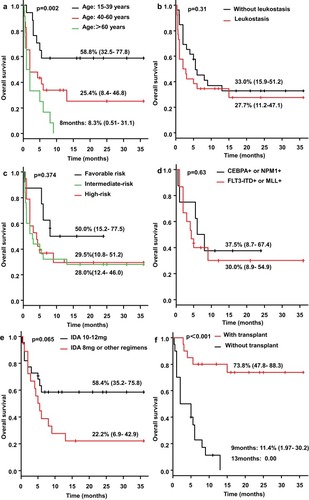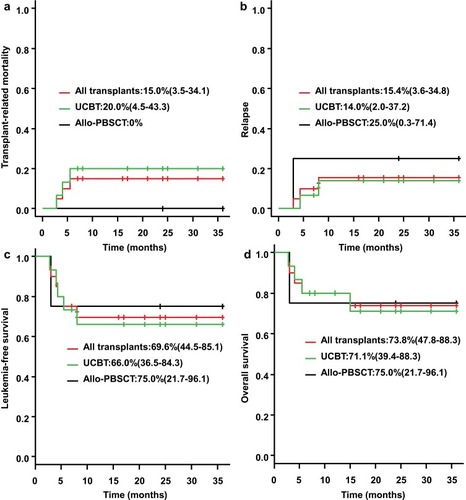Figures & data
Table 1 Clinical Characteristics
Table 2 Transplant Characteristics
Figure 2 Overall survival. The 3-year overall survival (OS) rate in the 15–39 years old and 40–60 years old group was 58.8% (95% CI: 32.5–77.8%) and 25.4% (95% CI: 8.4–46.8%), respectively; and the longest survival time in patients aged >60 years was only 8 months, and the 8-month OS rate was 8.3% (p=0.002) (A).The 3-year OS rate of patients with and without leukostasis was 27.7% (95% CI: 11.2–47.1) and 33.0% (95% CI: 15.9–51.2%), respectively (p=0.31) (B). The 3-year OS rate of the patients in the favorable risk group, intermediate risk group and high risk group was 50% (95% CI: 15.2–77.5%), 28.0% (95% CI: 12.4–46.0%), and 29.5%(95% CI:10.8–51.2%), respectively (p=0.374) (C). The 3-year OS rate of patients carrying CEBPA or NPM1 mutation and those with FLT3-ITD or MLL mutation was 37.5% (95% CI: 8.7–67.4) and 30.0% (95% CI: 8.9–54.9%), respectively (p=0.63) (D). The 3-year OS rate of patients employing an induction regimen of a standard IA regimen was 58.4% (95% CI: 35.2–75.8%), and of those employing a non-standard IA regimen was 22.2% (95% CI: 6.9–42.9%) (p=0.065) (E). The 3-year OS rate of the transplantation patients reached 73.8% (95% CI: 47.8–88.3%), while the 9-month OS rate of patients without transplantation was 11.4% (95% CI: 1.97–30.2%) (p<0.001) (F).

Figure 3 TRM, relapse and survival of patients in transplant. The 3-year transplant-related mortality (TRM) rate was 15% (95% CI: 3.5–34.1%) in all transplant patients, and the 3-year TRM in UCBT patients was 20% (95% CI: 4.5–43.3%), and allo-PBSCT patients showed no transplant-related death (A). The 3-year relapse rate for transplant patients was 15.4% (95% CI: 3.6–34.8%), of whom the 3-year relapse rate for UCBT patients was 14.0% (95% CI: 2.0–37.2%), and the 3-year relapse rate for allo-PBSCT patients was 25% (95% CI: 0.3–71.4%) (B). The 3-year leukemia-free survival (LFS) rate for all transplant patients was 69.6% (95% CI: 44.5–85.1%), including 66% for UCBT patients (95% CI: 36.5–84.3%) and 75% for allo-PBSCT patients (95% CI: 21.7–96.1%) (C). The 3-year OS rate for UCBT patients was 71.1% (95% CI: 39.4–88.3%) and for allo-PBSCT patients was 75.0% (95% CI: 21.7–96.1%) (D).


